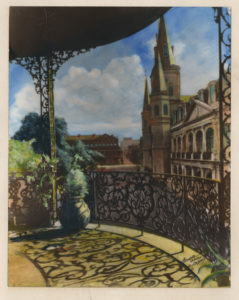C. Bennette Moore
C. Bennette Moore established himself as a photographer of both portraits and scenic locales in New Orleans in the early decades of the twentieth century.

Courtesy of The Historic New Orleans Collection
View of Cathedral from Lower Pontalba Balcony. Moore, C. Bennette (artist)
C. Bennette Moore established himself as a photographer of both portraits and scenic locales in New Orleans in the early decades of the twentieth century. He was a major figure in that profession by the time of his death, having worked four decades behind the camera and in the darkroom. The Moore Studio’s legacy included not only the photographs of its founder, but the work of Moore’s successors, his wife, daughters, and granddaughter, who operated the C. Benette Moore Studio until the late 1960s.
Moore was born in Sauk Center, Minnesota, on February 20, 1879. At age nineteen, he served in the Second Division Hospital Corps of the Second Army during the Spanish–American War. Following his tour of duty, in 1899 Moore relocated to New Orleans, where his brother, Frank B. Moore, was working as a photographer. However, Moore did not ally himself with his sibling, but chose instead employment in the studio of Julien Emile Rivoire at that firm’s final location on Baronne Street in the city’s business district.
On November 8, 1901, Moore married Elise Wehrmann of New Orleans. Three years later, he bought Rivoire’s business and rebranded it as his own. The 1917 publication Club Men of Louisiana included Moore in one of its caricature profiles, alluding to his portrait specialty by showing him with a large studio camera mounted on a dolly, while asking his customers to “watch the little bird.” Moore’s clients included individual members of the business community, brides, and a number of Mardi Gras organizations, among them the krewes of Comus and Proteus, and the Mystic Club.
As successful as he was as a portrait photographer, Moore saw a market for scenic views of the area. Postcards of New Orleans had long been a staple for the tourist market, and though waning in popularity by the time of World War I, there was no shortage of New Orleans scenes in the form of stereographs—a pair of nearly identical images viewed with a special apparatus that gave the impression of three-dimensional space—the purposes of which were both educational and entertaining. The publication of Impressions of Old New Orleans (1926), by photographer Arnold Genthe (1869–1942) perhaps spurred a national interest in scenic views of the city. Moore saw the prospect of selling individual prints, symbolizing the uniqueness of the city’s subtropical setting and architecture, in sizes that could be effectively framed and displayed. In the 1930s, a series of Moore’s French Quarter scenes were reproduced as etchings available for purchase.
In the 1920s and 1930s the studio, by then located in the French Quarter at 314 Royal Street, produced these souvenir images in great quantities, in sizes ranging from a calling card to an easel painting. Though printed in black and white, the pictures often received hand-coloring, applied by Moore’s wife or daughters, Grace, Phyllis, Lisette, and Ruth.
On Friday, December 8, 1939, Moore went to work from his 5213 Prytania Street residence as usual. He complained of illness that morning and collapsed and died within minutes, of what was later determined to be a heart ailment. Moore Studio continued under the direction of his widow and daughters Grace Moore Kirby and Phyllis Moore Stoll, and garnered acclaim from the Professional Photographers of America (PPA) and Professional Photographers of Louisiana. Stoll served as the latter organization’s second president in 1949. She achieved a Master Photographer designation from the PPA. Another daughter, Lisette Moore Meyers, became a successful portrait painter. In the studio’s later years, Stoll’s daughter — C. Benette Moore’s granddaughter Eugenie Stoll Ragan (1933–2008) ran the business. Though there were precedents for women operating photography studios in New Orleans, the field, as was the case throughout the country, was dominated by men.
The Moore Studio was active both nationally and regionally in exhibition competitions of professional groups, in presenting lectures about lighting and other studio techniques, in the use of oils to color black-and-white images, and in teaching master classes at the PPA’s headquarters in Lake Winona, Indiana. When the business finally ceased operation in the late 1960s, the archive came under the stewardship of Joseph Bergeron, who had joined the firm earlier in the decade following his military service. As of 2011, the C. Bennette Moore Studio archive is housed at The Historic New Orleans Collection.
